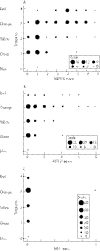Validation of physiological scoring systems in the accident and emergency department
- PMID: 17057134
- PMCID: PMC2464409
- DOI: 10.1136/emj.2006.035816
Validation of physiological scoring systems in the accident and emergency department
Abstract
Background: Scoring systems that weigh the degree of abnormality of bedside observations might be able to identify patients at risk of catastrophic deterioration.
Objectives: To establish a frequency distribution for typical physiological scoring systems and to establish the potential benefit of adding these to an existing triage system in accident and emergency departments.
Methods: Physiological data were collected from 53 unselected emergency department admissions, from 50 patients admitted from the emergency department to intensive care, and from 50 patients admitted from emergency department to general wards and then to intensive care. Three different physiological scores were calculated from the data. Identification of sick patients by the scores was compared with triage information from the Manchester Triage System (MTS).
Results: Most patients admitted to the emergency department would not be identified as critically ill with the aid of physiological scoring systems. This was true even for patients who were admitted to intensive care. Only in 0-8% of unselected patients did the scores indicate increased risk. In 100 patients admitted to the intensive care, adding of medical emergency team call-out criteria, Modified Early Warning Score or Assessment Score for Sick patient Identification and Step-up in Treatment would identify none, seven or one patient in addition to those triaged as orange and red by the MTS.
Conclusions: Introduction of a physiological scoring system would have identified only a small number of additional patients as critically ill and added little to the triage system currently in use.
Conflict of interest statement
Competing interests: CPS and LG have published on Early Warning Scores and received local research and development grants for this work. CPS is currently part of a group that has received a grant to examine the effect of outreach in England (NHS Service Delivery and Organisation Research and Development Programme, outline proposal to evaluate outreach services in critical care (SDO/74/2004)).
References
-
- Goldhill D R, Sumner A. Outcomes of intensive care patients in a group of British intensive care units. Crit Care Med 1998261337–1345. - PubMed
Publication types
MeSH terms
LinkOut - more resources
Full Text Sources
Medical
Miscellaneous


